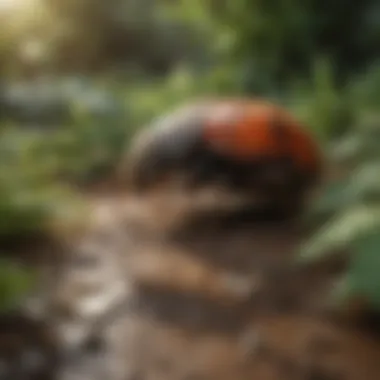Humble Pest Control: An In-Depth Exploration


Intro
The rising importance of sustainable living has compelled homeowners and gardeners to rethink their approaches to pest control. Understanding the nuances of pest behaviors is crucial. A balance needs to be achieved between protecting gardens and homes while maintaining the health of ecosystems. This article aims to spotlight humble pest control methods that respect our environment and offer effective solutions. Through examining pest definitions, identification methods, preventive techniques, and eco-friendly control solutions, readers will gain comprehensive insight into managing pests thoughtfully. Let's begin this exploration into an area that combines ecology with practicality.
Understanding Pests
Definition of Pests
Pests can be described as organisms that compete with humans for resources, causing various levels of harm. They often invade homes and gardens, resulting in unwanted competition for food, but not all pests are inherently harmful. Some insects play vital roles in pollination or pest control. The determination of a pest largely depends on perspective and situation. Identifying what constitutes a pest in your specific context is the first step towards effective management.
Importance of Pest Identification
Identifying pests accurately holds significant value in pest control management. Misidentification can lead to ineffective treatment strategies that may exacerbate the problem. Each pest may require specific methods for control, as their behaviors and life cycles can differ markedly. Moreover, being aware of what you are dealing with enables targeted interventions, reducing dependency on harmful chemicals. Homeowners should observe signs of pest activity regularly. Such diligence can provide insight into pest populations, allowing more precise action.
Prevention Techniques
Home and Garden Preventative Measures
Preventive measures are crucial components of any pest control strategy. Here are some effective tactics:
- Maintain cleanliness: Regularly cleaning kitchens, dining areas, and orchards helps reduce food sources for pests.
- Seal entry points: Carefully inspect your home for cracks, gaps, or holes that pests might use for access, repairing these weaknesses is effective.
- Use physical barriers: Employ the use of nets or protective covers on plants to limit pest access.
Seasonal Prevention Tips
Adapting to seasonal changes can further enhance pest management efforts. Different pests become active at various times of the year. Understanding the seasonality of pest behavior can inform preventative actions:
- Spring: Begin inspecting and repairing any damage from winter, as pests look to invade.
- Summer: Monitor gardens closely for any pest infestations that may occur as weather warms up.
- Autumn: Clean fallen leaves and debris that may attract pests preparing for winter.
Eco-Friendly Pest Control Solutions
Overview of Sustainable Practices
Eco-friendly pest control emphasizes the use of natural and sustainable practices, minimizing harmful effects on the environment. Techniques such as Integrated Pest Management (IPM) combine monitoring pest populations with preventive measures and limited pesticide use. This contrasting method encourages the growth of beneficial organisms while reducing reliance on chemicals.
Natural Remedies and Their Effectiveness
Natural remedies can offer effective alternatives for pest control. Here are some popular options that homeowners can consider:
- Diatomaceous earth: A natural abrasive that can deter pests physically when sprinkled in targeted areas.
- Essential oils: Oils like peppermint or tea tree may repel various insects.
- Neem oil: Extracted from the seeds of the neem tree, it disrupts the life cycle of pests on contact.
"Eco-friendly pest control does not aim to eliminate all pests, but to manage them wisely."
Through understanding pests, enhancing prevention techniques, and employing sustainable practices, homeowners can protect their spaces while supporting the delicate balance of ecosystems. This comprehensive approach encourages a healthier coexistence with our environment.
Prelims to Humble Pest Control
Humble pest control represents an essential shift in how we view and manage pests in our homes and gardens. Traditional pest management often prioritizes immediate eradication, sometimes at the cost of ecological balance. This approach seldom considers the broader implications that arise from these actions. By focusing on eco-friendly and sustainable methods, humble pest control aims not only to address pest problems but also to respect the ecosystems in which they exist.
The discussion around humble pest control is significant for various reasons. First, it highlights the need for a more nuanced understanding of pests, moving away from the notion that all pests are inherently harmful. Many pests play vital roles in their ecosystems, contributing to processes like pollination and organic matter breakdown. When we approach pest control with humility, we acknowledge these contributions and strive for solutions that minimize harm.
Incorporating principles of sustainable pest management also offers numerous benefits. Homeowners can achieve effective pest control without relying heavily on chemical pesticides, which can pose risks to health and the environment. Emphasizing preventive measures and natural remedies not only addresses pest issues but fosters a healthier living environment.
Furthermore, this perspective encourages ongoing education and a proactive mindset among homeowners. Instead of waiting for pest problems to arise, individuals can learn to recognize signs of pests and implement strategies to keep them at bay. This empowers homeowners and cultivates a sense of responsibility toward their home environments.
In summary, the exploration of humble pest control firmly establishes its relevance in today's ecological climate. It advocates for a balanced approach focused on sustainability. Understanding this concept will lead to informed decisions and practices that promote a harmonious coexistence with nature.
Definition of Humble Pest Control
Humble pest control can be defined as a pest management approach that seeks to minimize environmental impact while effectively addressing pest problems. This strategy emphasizes understanding the ecology of pests, promoting awareness of their roles within ecosystems, and finding solutions that work within these natural systems. It recognizes the importance of coexistence and aims to achieve pest management goals without causing undue harm to the environment.
Historical Context and Evolution
Historically, pest control practices often revolved around the use of harsh chemicals developed in the early to mid-20th century. While these methods were effective in achieving quick results, they frequently led to unintended consequences, such as resistance among pest populations and negative side effects on non-target organisms, including beneficial insects and human health.
As awareness of these issues grew, so did the need for innovative solutions. The movement towards humble pest control began gaining traction in the late 20th century with the advent of Integrated Pest Management (IPM). This method combined conventional pest control strategies with ecological principles to promote long-lasting solutions.
Over the years, the evolution of pest control has been shaped by advances in research and technology. There is now a greater emphasis on environmentally friendly alternatives. Today, humble pest control integrates both scientific insights and a philosophical shift towards recognizing pests as part of the broader ecosystem. This evolution reflects a growing commitment to sustainability and responsibility in pest management practices.
Understanding the Pest Perspective
Understanding pests is crucial for effective pest management. It offers insight into how pests operate, which can greatly inform the strategies used to manage their populations. When homeowners comprehend common pest behaviors and ecological roles, they can develop tailored approaches that align with eco-friendly principles.


Common Pest Behaviors
Pests do not act randomly; they exhibit specific behaviors driven by survival instincts. For instance, ants are known for their foraging habits, while rodents often seek shelter and food sources in warm areas, especially in homes. Recognizing such habits allows homeowners to create preventive measures effectively.
Some common behaviors include:
- Foraging: Pests like cockroaches and ants actively search for food, often looking for items that are easily accessible. Keeping kitchens clean and storing food in sealed containers can help.
- Nesting: Various pests, such as mice, prefer undisturbed locations for nesting, which is why attics or basements may attract them. Regular inspection of such areas can aid in early identification and control.
- Reproduction: Understanding the reproductive cycle of pests like bedbugs can help in timing treatment to interrupt infestations effectively.
Recognizing these behaviors not only makes it easier to spot signs of pest activity but is also essential for proving successful interventions that respect the balance of the ecosystem.
Ecological Roles of Pests
Pests play significant roles in maintaining ecological balance. While they often are viewed as nuisances, their presence in ecosystems is multifaceted.
- Food Sources: Many pests serve as food for other animals. For example, spiders are predators of insects and contribute to controlling pest populations.
- Pollination: Certain pests, like butterflies and bees, play roles in pollinating plants, which is vital for plant reproduction and maintaining biodiversity.
- Decomposition: Some pests, such as ants, help in the decomposition process by breaking down organic matter, enriching the soil.
Understanding these roles fosters a deeper appreciation for the interconnectedness of species and ecosystems. Recognizing that pest management should avoid disrupting natural processes encourages a balanced, respectful approach to pest control.
It's essential to view pests within the context of their environments; doing so can transform how we tackle pest management.
Incorporating an understanding of pest behaviors and their ecological roles into pest management strategies allows for a more holistic approach, ultimately leading to more effective and sustainable outcomes.
Principles of Eco-Friendly Pest Management
Understanding the principles of eco-friendly pest management is crucial in cultivating an effective strategy for controlling pest populations while minimizing harm to the environment. This multifaceted approach recognizes that a delicate balance exists between humans, pests, and ecosystems. By prioritizing sustainable methods, not only can we maintain the integrity of our surroundings, but we also contribute to a healthier planet.
Integrated Pest Management (IPM)
Integrated Pest Management, commonly referred to as IPM, stands as a cornerstone of eco-friendly pest control. The IPM approach emphasizes the need for informed decision making when it comes to addressing pest issues. It incorporates various control methods such as biological control, habitat manipulation, and the judicious use of chemical pesticides when necessary. The main goal of IPM is to reduce pest populations to acceptable levels, rather than aiming for total eradication.
Some essential elements of IPM include:
- Monitoring: Regularly inspecting your environment for pest activity. This helps in understanding pest populations and their behaviors.
- Identification: Accurately identifying pests is vital. Misidentifying pests can lead to ineffective control measures and unnecessary harm to beneficial species.
- Prevention: Employing preventive measures can significantly reduce pest invasions. This could be keeping areas clean, sealing entry points, and using resistant plant varieties.
- Control: Utilizing a combination of control methods. This includes cultural, mechanical, and biological control along with chemical methods as a last resort.
The effectiveness of IPM lies in its customized approach, which considers the specific circumstances of each situation. For homeowners, implementing IPM means being proactive. It ensures that pest control is not just reactive, but also thoughtful and informed.
Sustainable Control Techniques
Sustainable control techniques build upon the principles of IPM, focusing on long-term solutions rather than quick fixes. These methods aim to address pest problems while safeguarding the environment. Some notable techniques include:
- Natural Predators: Introducing or encouraging natural predators in the garden environment can help keep pest populations in check. For example, ladybugs effectively control aphid populations.
- Crop Rotation: This method involves alternating the types of crops grown in a particular area to disrupt pest life cycles. It is commonly used in gardens and agricultural practices.
- Companion Planting: Certain plants can repel pests or attract beneficial insects. For instance, planting marigolds alongside vegetables can deter nematodes.
- Organic Pesticides: When necessary, using organic pesticides can minimize harm to non-target organisms and lessen the chemical load on the environment. Products like neem oil can disrupt pest life cycles effectively.
As homeowners adopt sustainable control techniques, it is important to evaluate the effectiveness of these methods over time. The emphasis should be on finding solutions that respect the ecosystem while effectively managing pests.
"By understanding pest behaviors and the roles they play, we can approach pest management in a sustainable way that honors the balance of our ecosystem."
Identification of Common Pests
Recognizing common pests is a foundational element in pest management. Homeowners and gardeners need to accurately identify pests to apply suitable control measures. Misidentification can lead to inappropriate treatments that might not solve the problem or could cause harm to the surrounding ecosystem. Understanding which pests are present helps in assessing the potential damage they may cause. Each species has its own habits, diets, and ecological roles, making identification crucial for effective control strategies.
Pest identification is not only about spotting the intruder but also understanding its behavior and life cycle. This knowledge assists in developing targeted interventions that are both effective and environmentally friendly. With a clear understanding of how pests operate, homeowners can not only deal with existing infestations but also implement preventive measures to avoid future ones.
Visual Identification Techniques
Visual identification involves examining physical traits of pests. This can include size, color, and body shape. Each pest species has distinct features that help in recognition. For example, termites and ants may seem similar, but key differences in antenna shape and body segmentation can aid in proper identification.
When inspecting for pests, consider the following steps:
- Observe: Take time to look at suspected areas for any signs of pests. Look for droppings, nests, or remnants.
- Photograph: If possible, take a clear image of the pest for further analysis or to consult with an expert.
- Use Guides: Utilize resources such as pest identification charts or apps that can help match characteristics with known pests.
This process can often reveal the types of infestations, which can influence the approach for treatment.
Behavioral Indicators of Infestation
Beyond physical appearance, behavior can provide significant clues about pest presence. For example, gnawing sounds or marks on wood may indicate a rodent infestation. Ant trails are another obvious sign, as they typically march in a line towards food sources.
Awareness of specific behaviors can help in early detection:
- Feeding Habits: Look for signs of damage to food items, plants, or structures, as these reflect feeding activity.
- Trail Patterns: Pests like ants and cockroaches often leave trails, which can guide you to their source.
- Sights and Sounds: Listen for unusual noises, especially at night. Many pests are nocturnal and more active during these hours.
"Identifying pests not just prevents damage to property but also protects health and wellbeing. Understanding what you are dealing with is half the battle in effective pest management."


Using both visual and behavioral techniques together enhances the likelihood of accurate pest identification. This approach not only informs control methods but also gives insights into pest behaviors, making future interactions with these organisms more manageable.
Preventive Measures for Pest Control
Preventive measures for pest control are essential in maintaining a harmonious living environment. Rather than waiting for infestations to occur, a proactive approach can significantly reduce the likelihood of pest problems. This not only helps in preserving the integrity of homes but also contributes to the well-being of surrounding ecosystems. The benefits of preventive measures are numerous and varied.
Effective prevention strategies can lead to financial savings. If homeowners invest time and effort in routine maintenance and inspections, they can avoid the costly consequences of pest infestations. Addressing minor issues before they escalate saves both money and resources.
Pest control measures also align with a sustainable approach. By focusing on prevention, it minimizes the reliance on chemical treatments, which can have detrimental effects on health and the environment. Natural barriers and routine checks allow for a balance between habitation and pest presence, fostering an ecosystem that respects all living organisms.
Homeowners should consider implementing both routine home maintenance practices and landscaping strategies. These elements play a vital role in establishing a pest-free environment. A well-maintained home and strategic landscaping not only deter pests but also create a more enjoyable and safe space for residents.
Routine Home Maintenance Practices
Routine home maintenance is a cornerstone of effective pest control. Regular inspections and upkeep of household areas can identify potential pest entry points before they become significant issues. Homeowners should prioritize several key practices:
- Sealing Entry Points: Check for cracks and gaps in walls, windows, and doors. Sealing these points prevents pests from infiltrating the home.
- Proper Waste Management: Regularly dispose of garbage and keep outdoor areas clean. Pests are often attracted to food residues, so ensuring proper waste disposal is vital.
- Routine Inspections: Conduct periodic checks in areas like attics, basements, and crawl spaces. Early detection of insects such as termites or rodents can facilitate preventive measures before extensive damage occurs.
By integrating these practices into a regular cleaning routine, homeowners can greatly minimize the risk of pest invasions. Additionally, being aware of the specific pests common to the region can further enhance these efforts. Informational resources, such as Wikipedia can offer insights into local pest behavior and identification.
Landscaping Strategies to Deter Pests
Landscaping is often overlooked in discussions about pest management, yet it has a significant impact on pest presence in and around property. Thoughtful landscaping can create an inhospitable environment for pests. Here are some useful strategies:
- Diverse Plant Selection: Cultivate a variety of plants. Some plants naturally repel pests while attracting beneficial insects that prey on pests.
- Regular Maintenance: Keep plants trimmed and remove any dead or decaying foliage. Overgrown areas can harbor pests, so it's important to maintain garden vitality.
- Strategic Mulching: Use cedar or pine mulch, which can help deter pests like ants and termites.
- Water Management: Ensure that standing water is not present in the landscape. This can help prevent mosquitoes and other water-related pests from breeding.
Implementing these landscaping considerations not only aids in pest control but also promotes overall garden health and aesthetics, enhancing the outdoor experience for homeowners.
"An ounce of prevention is worth a pound of cure." - Benjamin Franklin
In summary, preventive measures such as routine home maintenance and intentional landscaping hold significant power in controlling pest populations. They ensure a balance in our environments, promoting both safety and sustainability.
Eco-Friendly Pest Control Solutions
Eco-friendly pest control solutions are essential in the current climate of environmental awareness and sustainability. These methods not only target pest problems but also minimize harmful impacts on the ecosystem. The significant advantage of implementing eco-friendly solutions is their potential to reduce chemical usage, leading to healthier living spaces and habitats.
When homeowners consider pest control, they should prioritize solutions that don’t harm beneficial insects or pollinators. Such practices help maintain the ecological balance, ensuring that the local flora and fauna thrive. Furthermore, adopting these methods promotes long-term pest management strategies rather than quick-fix solutions that often fail to address the root of the problem.
Natural Repellents and Traps
Natural repellents and traps are effective alternatives to harsh chemicals. Many plants act as natural deterrents against pests. For example, marigolds are particularly known for repelling nematodes and aphids. Using essential oils, such as peppermint or lavender, can mask scents that attract pests, creating an inhospitable environment for them.
Traps can be homemade or purchased and involve non-toxic materials. A simple trap can consist of soap and water for catching flying insects. Sticky traps made from biodegradable materials can catch various pests without releasing dangerous substances into the environment.
"Utilizing natural repellents not only protects your home but also contributes positively to local ecosystems."
When choosing traps, consider the target pests and the safest materials available. This consideration will ensure that non-target organisms are not negatively affected. Combining multiple methods can enhance overall effectiveness and reduce reliance on any single technique.
Biological Control Agents
Biological control agents involve using natural enemies to combat pests. This method includes predators, parasites, or pathogens that can help regulate pest populations. For instance, ladybugs feed on aphids, while nematodes can attack soil-dwelling larvae of various insects.
Implementing these agents requires some understanding of pest life cycles and behaviors. It may take time, but the results are often more sustainable compared to traditional chemical methods. Additionally, biological control does not contribute chemical residues in the environment, making it a safer option for families and pets alike.
In many cases, integrating biological control with other eco-friendly practices creates a multi-faceted approach to pest management. Eco-friendly solutions empower homeowners to make informed decisions, prioritize sustainability, and foster a healthy, balanced ecosystem.
The Role of Professional Pest Control Services
Professional pest control services play a crucial role in managing pest issues effectively. Many homeowners often face challenges when dealing with pest infestations. For those times when self-management fails or when an infestation is severe, enlisting a professional becomes more than a convenience; it may be a necessity. Pest control professionals bring expertise that is invaluable in understanding the biology and habits of various pests. They can effectively identify the source of an infestation and offer tailored solutions to address the problem.
Additionally, these services help in preventing potential damages to property. Many pests, such as termites, can cause significant structural damage if not dealt with promptly. A timely intervention can save homeowners from costly repairs later on. Furthermore, professionals use methods and products that are often more effective than consumer-grade solutions. Homeowners may not have access to or knowledge about these advanced techniques, adding another layer of importance to hiring experts.
When to Seek Professional Help
Recognizing when to call in professionals can be tricky. However, there are clear indicators that suggest it may be time to seek help. Here are a few signs:
- Persistent Infestation: If pests keep returning despite your efforts, it’s time to consult an expert.
- Magnitude of the Problem: Large infestations, like a rodent or termite invasion, often require professional intervention.
- Health Risks: Some pests may pose health risks, such as bedbugs or cockroaches. In such cases, professional services can ensure a thorough and safe extermination.
- Uncertainty of the Pest: If you are unsure about the type of pest and how to deal with it, a professional can provide an accurate identification and method of control.
Evaluating Pest Control Providers
Choosing the right pest control provider can be a daunting task. Homeowners should consider several factors before making a decision. Here’s what to think about:


- Certifications and Licensing: Ensure the provider is certified and licensed to perform pest control in your area. This guarantees they meet specific professional standards.
- Experience: Inquire about the company's experience with specific pests. Longer operating times often correlate with a deeper understanding of effective treatment options.
- Techniques Used: Ask about the methods they employ. Eco-friendly solutions can be vital for those concerned about the environment and health.
- Customer Reviews: Look for online testimonials and reviews from previous clients. This can provide insight into their service quality.
"Professional pest control can not only eliminate infestations but also prevent them from recurring in the future."
Considering these elements carefully enhances the likelihood of finding a service provider that meets your needs. Inadequate pest control solutions can lead to ongoing issues, making it essential to perform thorough research before selecting a contractor.
Legislative and Regulatory Considerations
Legislation and regulation surrounding pest control practices play a crucial role in shaping eco-friendly pest management. Understanding these considerations helps homeowners and responsible pest management professionals operate within the legal framework while promoting safe and sustainable methods. Different countries and localities have specific rules designed to minimize the risks associated with pesticide use, protect beneficial organisms, and safeguard human health.
Environmental Regulations Affecting Pest Control
Environmental regulations can greatly influence pest control strategies. Regulations often establish limits on the type and quantity of pesticides that can be used. This is essential for protecting ecosystems and preventing contamination of soil and water sources. Important elements to consider include:
- Pesticide Registration: Chemicals used for pest control must be registered with environmental agencies. This ensures they meet safety standards. For example, in the USA, the Environmental Protection Agency (EPA) oversees this process.
- Usage Restrictions: Specific areas, such as schools and hospitals, may have stricter regulations on pesticide application. Homeowners should be aware of proximity to sensitive environments when choosing pest control solutions.
- Disposal Guidelines: Proper disposal of leftover pesticides is vital. Regulations provide detailed procedures to prevent environmental liability.
In accordance with these guidelines, adopting pest control measures that comply with legal expectations demonstrates a commitment to public safety and environmental stewardship.
Consumer Rights in Pest Management
Understanding consumer rights in pest management is also vital for ensuring fair practices. Homeowners have the right to:
- Informed Decision-Making: Consumers should receive clear information about the pest control methods being applied. This includes the substances used, their risks, and their benefits. Knowledgeable decision-making leads to safer outcomes.
- Service Quality Assurance: Homeowners are entitled to a certain standard of service when contracting professional pest control services. This includes timely responses and effective solutions.
- Access to Alternatives: If more harmful methods are proposed, consumers should be informed of eco-friendly alternatives. This ensures that clients can make choices aligned with their values.
"A well-informed consumer can advocate for safer, more sustainable pest management practices."
In summary, grasping the legislative and regulatory landscape is essential for homeowners and pest control professionals. It enhances awareness of the responsibilities and rights involved, thus promoting sustainable pest control practices that safeguard health and environment. By following these standards, individuals contribute to a more harmonious coexistence with nature.
Future Trends in Pest Management
Future trends in pest management are critical for understanding how techniques and technologies evolve in response to the changing environmental landscape. As the world becomes more aware of ecological concerns, it is imperative that pest control methods align with sustainable practices. Proactive approaches to pest control can no longer rely solely on chemical solutions. This shift is necessary for protecting the environment while maintaining health and safety in homes. Keeping abreast of trends in this field allows homeowners to anticipate changes and adopt best practices effectively.
Technological Innovations in Pest Control
Technological advancements play an essential role in revolutionizing pest management. One notable innovation is the use of smart traps that employ sensors and connectivity to monitor pest populations in real-time. These devices can track not only the presence of pests but also the timing and frequency of infestations, enabling targeted interventions.
Drones are also making waves by allowing for aerial surveys of large properties. This method can identify potential pest hotspots before they escalate into larger problems. Another trend involves artificial intelligence and machine learning algorithms that analyze data from various sources, providing pest control professionals with insights that inform strategy and action.
Home automation is another area where technology shines. Smart home systems can integrate pest detection devices. For example, ultrasonic repellents can be programmed to activate based on environmental triggers, providing a novel way to deter pests without harmful chemicals.
Shifts Towards Sustainable Practices
In the context of pest management, a significant shift is seen towards sustainable practices. Homeowners and professionals alike are recognizing the importance of minimizing chemical usage. This shift reflects a growing concern for public health and environmental integrity. The use of biological pest control methods, such as introducing beneficial insects like ladybugs or lacewings, promotes a form of natural balance in ecosystems, effectively managing pests without causing harm.
Furthermore, education plays a vital role in this transformation. Increased awareness of the environmental consequences of pesticides has led to demand for organic and eco-friendly solutions. Home gardeners are now more inclined to use neem oil or insecticidal soaps, which are less toxic and provide effective pest management.
In summary, the trends in pest management focus on technological advancements and sustainable practices. These developments offer homeowners viable options to ensure pest control that is not only effective but also environmentally responsible. By adopting innovative tools and methods, individuals contribute to a healthier home environment and a sustainable future for the ecosystem.
"Future trends are not just about immediate solutions but preparing for long-term ecological stability."
As the industry progresses, maintenance of this harmony between effectiveness and environmental stewardship will be crucial.
The End and Reflection
The conclusion serves as a pivotal element of this article, emphasizing the significance of humble pest control practices. It integrates the discussions previously made about pest behavior, sustainable techniques, and the ecological balance. Importantly, it encapsulates the shared insights into the complex relationship between pests and human habitats, prompting readers to consider their own roles in this intricate ecosystem.
Reflecting on key themes, the article illustrates that pest management is not merely about elimination but rather about understanding and coexistence. It guides homeowners to make informed decisions that favor sustainable approaches over potentially harmful chemical applications. Emphasizing environmental stewardship, this closing segment makes clear the benefits of adopting integrated pest management strategies, which safeguard both the home environment and ecological health.
"The core of effective pest management lies not only in preventing pests but also in recognizing their ecological functions."
Thus, the reflection on various elements of pest control reinforces the need to respect nature while effectively managing pest populations. It often involves striking a balance, one that does not sacrifice safety for convenience but rather fosters a deeper appreciation for biodiversity in our surroundings. This perspective is especially crucial for homeowners looking to maintain harmony within their spaces.
Summary of Key Points
The article has highlighted several important aspects:
- The necessity of understanding pest behaviors and ecological roles.
- The principles that underpin eco-friendly pest management.
- Practical strategies for identification and prevention of pests.
- The valuable role of professional services when needed.
- The future direction of pest management emphasizing sustainability and technology.
Each section contributes to a holistic view of pest control that prioritizes harmony with the environment.
Encouraging Sustainable Practices
Promoting sustainable practices is intertwined with the overarching theme of this article. It is crucial that homeowners adopt methods that minimize their impact on the environment. There are several effective strategies to consider:
- Use of natural repellents such as essential oils can deter pests without harmful chemicals.
- Encouragement of beneficial insects like ladybugs, which naturally control pest populations.
- Regular maintenance of home interiors and exteriors prevents infestations.
- Informed landscaping choices can deter undesirable pests.
Additionally, public awareness is key. Engaging in community discussions or local initiatives can reinforce the culture of using sustainable practices. By fostering a community-wide commitment to eco-friendly methods, the benefits of humble pest control can be amplified, creating lasting impacts beyond individual households.



